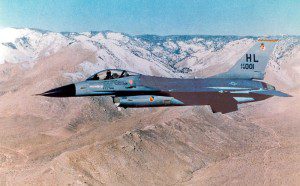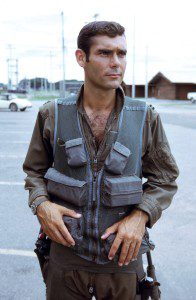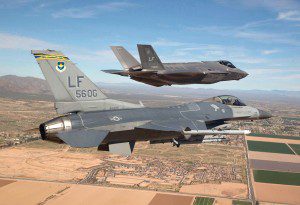The first operational F-16A was delivered to the 388th Tactical Fighter Wing at Hill AFB, Utah, on Jan. 6, 1979. The earliest F-16 student training was accomplished at Hill, and Capt. Edwin “Skip” Hopler was part of the initial cadre of F-16A instructors. He was one of the first 50 pilots to fly the F-16. Little did Skip know that he would become an integral part of all F-16 training for the next 40 years.
Tactical Air Command soon identified MacDill AFB in Florida to be the “schoolhouse” for the F-16. Starting in 1980, the 56th Tactical Training Wing at MacDill began to convert from the F-4D to F-16A/B aircraft, completing the transition in 1982. Skip Hopler would become the commander of the 63rd Tactical Fighter Training Squadron at MacDill from June 1984 to May 1986.

The 58th TTW at Luke AFB, Arizona, was also identified as a future F-16 training wing. In April 1982, the 310th and 311th TFTSs at Luke began converting from the F-4C to the F-16A/B. The 310th TFTS began formal student training on Feb. 2, 1983, and the 311th began student training shortly thereafter. A third squadron, the 312th TFTS, joined the wing in mid-1983.
All three squadrons were flying the F-16A (block 10) aircraft. The 58th TTW was quickly growing. The 312th TFTS converted to the newer F-16C/D (block 25) in early 1986. A fourth squadron, the 314th TFTS, became operational in October 1986, also flying the F-16C/D.
TAC managed the F-16 student training at both MacDill and Luke.
The two TX classes that preceded my class consisted mostly of pilots who were transitioning from the F-4 to become F-16 instructors.
Following my training, I went to Kunsan Air Base in Korea for a year. I returned to Luke in December 1984 and completed an instructor course, again with the 310th. I was attached to the 311th TFTS for flying, but my primary job was chief of the Current Operations Division (DOO). This was a very busy job.
The office managed the wing’s programmed flying training commitment in addition to managing the daily flying schedule and each squadron’s hour/sortie accomplishments. DOO was also where the “cats and dogs” of the wing were sent. These requests included static displays, flyovers, speaking to community groups, and many other flying activities that did not deal directly with student training.
At that time, there were two training wings at Luke. The 405th TTW was flying the F-15D, and it was the larger of the two wings. Besides having several F-15 equipped squadrons, the 405th also had the 425th TFTS at Williams AFB, Arizona. This squadron provided training in the F-5 for foreign pilots as part of the Military Assistance Program.
Because of its size, the 405th was considered the host wing at Luke. The 58th was considered the tenant Wing. Both wings fell under operation command of the 832nd Air Division, which was also headquartered at Luke.
The DOO office consisted of myself, three other officers, and four enlisted personnel. In the 1980s, computers were in their infancy, and DOO had the only computer on base capable of managing the F-16 PFT for each squadron. By today’s standards, this computer program was very crude, but it was much better than manual calculations of sortie requirements to meet the TAC training needs. Each squadron was tasked with a PFT loading of approximately 85-87% of their annual sorties.
At some point in my time as DOO chief, the idea of inflight photography of all the Luke aircraft came up during an 832nd Air Division meeting. Personal cameras in the cockpit were strictly forbidden, but professional photographs of the Luke aircraft flying together sounded appealing. Our wing director of operations, Col. Joe Rively, offered to turn this desire into reality.
Immediately after the meeting, he walked into my office and said he had a project for me. He and I worked well together, and he frequently walked in unannounced to discuss challenging projects. When he brought up the idea of inflight photography, I gladly accepted the challenge.
Very few people knew that I had tried out for the Thunderbirds twice and that I was familiar with photo friendly formations. For years I had kept that tidbit very close to the chest. Now I had an opportunity to use that experience to preserve Luke AFB history.
The first call was to the Air Force Audio Visual Center at Norton AFB, California. I was able to schedule an Air Force photographer to fly in the rear cockpit of an F-16B for a two-day photoshoot. The second day would be a backup in case the weather cancelled the primary mission. The objective was to take pictures of the Luke flagships flying together in scenic locations around Arizona. Working with my counterpart in the 405th TTW, we scheduled the mission.

I was flying the F-16B with the photographer from Norton in my back seat. My job was to choreograph the aircraft to fly in formation positions suitable for the camera. Flying in a photo shoot was very different than the normal formation positions the pilots were used to. The spacing between aircraft and the high stacking of the aircraft farthest from the camera needed to be precise to compose a balanced photograph of the four aircraft. The three dissimilar aircraft only complicated the formation as seen by the camera.
We wouldn’t see the results of the mission for nearly a month. The film was developed at Norton, and the photographer mailed me proof sheets to review. Rively and I reviewed the proofs and selected the best ones for printing. The mission had been a success. We had captured and preserved an important part of Luke’s history.
We flew a second photo mission a few months later. Three F-16s flew in this mission, and we wanted to capture not only Arizona’s scenic beauty, but also an overflight of Sun Devil Stadium and the City of Glendale municipal building. This mission was also a success.
In early 1988, I decided to retire from the Air Force. I met with Colonel Rively and informed him of this decision. I told him I had no interest in flying for the airlines, and he quickly had a comeback employment opportunity. He told me that the Air Force was laying the groundwork for contractor instruction in the classroom and the simulator.
Rively suggested that I go to the academic building and speak with Cass Cassaro. I learned that a company named Simuflite had been awarded the contract for instruction at both Luke and MacDill. Simuflite was looking for F-16 qualified instructor candidates.
The interview went well, and I could sense that Simuflite was very interested in offering me a job. They told me that they had already made an offer to someone on the TAC staff at Langley AFB who was retiring shortly. That offer was to be the chief instructor at Luke.
Little did I know that the person at Langley they were referring to was Lt. Col. Edwin A. “Skip” Hopler.
Skip accepted the position, and Simuflite made me an offer to join him in a similar management position.
I joined Skip as one of the “founding fathers” of contract instruction at Luke. I spent 27 more years at Luke, and it was both meaningful and personally rewarding to be a part of the continually changing F-16 era. Skip went on to become the program manager for F-16 and F-35 training at Luke.

Significant changes occurred on October 1, 1991. The 58th TTW was redesignated as the 58th Fighter Wing, the 405th TTW was deactivated, and three F-15 squadrons moved to the 58th FW. All the fighter training squadrons were reassigned to the new 58th Operations Group.
Luke served as the singular F-16 training base for more than 20 years. On March 31, 2011, the Air Force announced that the F-35 would be replacing the F-16 as the primary aircraft at Luke. It was later announced that a total of 144 F-35s would be based at Luke, and F-16 training would be moved to Holloman AFB, New Mexico. The 311th FS was the first squadron to move to Holloman. It was activated there on March 1, 2014. The 314th FS was activated at Holloman on July 14, 2015.
The first F-35 arrived at Luke on March 10, 2014. F-16 training continued at Luke on a reduced level with the 54th OG at Holloman gradually assuming more of the training responsibility.
The 56th FW graduated its last F-16 class in September of 2024, and all U.S. Air Force F-16 student training officially ended on Oct. 31. A minimal amount of F-16 flying is scheduled to continue until March 31, 2025. A celebration honoring the F-16 era at Luke will be held on March 28, 2025.
Lt. Col. Edwin A. “Skip” Hopler passed away on May 19, 2023. He had been an F-16 instructor at Hill. MacDill, and Luke. On March 29, 2024, the F-16 and F-35 academic and simulator training facility at Luke was renamed the Skip Hopler Fighter Training Center in remembrance of his abundant contributions in training the world’s greatest fighter pilots.










